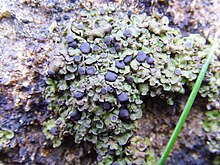| Solenopsora | |
|---|---|

| |
| Solenopsora holophaea, France | |
| Scientific classification | |
| Domain: | Eukaryota |
| Kingdom: | Fungi |
| Division: | Ascomycota |
| Class: | Lecanoromycetes |
| Order: | Lecanorales |
| Family: | Catillariaceae |
| Genus: | Solenopsora A.Massal. (1855) |
| Type species | |
| Solenopsora requienii A.Massal. (1855) | |
| Synonyms | |
Solenopsora is a genus of lichen-forming fungi in the family Catillariaceae. It has 15 species, with a mostly Northern Hemisphere distribution.
Taxonomy
The genus was circumscribed by Italian lichenologist Abramo Bartolommeo Massalongo in 1855, with Solenopsora requienii assigned as the type species. However, this species had previously been described in 1840 by Camille Montagne, as Parmelia holophaea.
Description
Solenopsora lichens produce thalli of various morphologies, including crust-like (crustose), scaley (squamulose), and leafy (foliose). Depending on the species, the apothecia may be immersed on the substrate, emergent on the substrate surface, or somewhat elevated on a stalk (stipitate). A combination of microscopic characteristics define the genus Solenopsora. They all have asci that contain eight spores, and are of the Catillaria-type. This means that they have a prominent, amyloid tholus (the thickened inner part of the tip of an ascus) that lacks any internal differentiation such as an axial body. They have simple (i.e. unbranched) paraphyses with an internal brown pigmentation and club-shaped tips. Their ascospores are colourless and translucent (hyaline), and contain a single septum.
Catillaria is a closely related genus that differs mainly in having a thallus that is always crustose, and apothecia with a proper margin.
Habitat and distribution
Most Solenopsora species are found in the Northern Hemisphere, including Asia, Europe, western North Africa, North America, and the Canary Islands. Three species are known from Australia. Eight species occur in Europe.
Species
As of December 2024, Species Fungorum accepts 15 species of Solenopsora:
- Solenopsora candicans (Dicks.) J.Steiner (1915)
- Solenopsora cesatii (A.Massal.) Zahlbr. (1919)
- Solenopsora chihuahuana B.D.Ryan & Timdal (2011)
- Solenopsora cladonioides B.D.Ryan & Timdal (2011)
- Solenopsora cyathiformis (Szatala) van den Boom (2004)
- Solenopsora elixiana Verdon & Rambold (1998) – Queensland; La Réunion; Taiwan
- Solenopsora grisea (Bagl.) Kotlov (2004)
- Solenopsora holophaea (Mont.) Samp. (1921)
- Solenopsora isidiata van den Boom & Ertz (2012)
- Solenopsora liparina (Nyl.) Zahlbr. (1919)
- Solenopsora olivacea (Dufour) H.Kilias (1981)
- Solenopsora requienii A.Massal. (1855)
- Solenopsora sordida (C.W.Dodge) D.J.Galloway (2004) – New Zealand
- Solenopsora tasmanica Kantvilas (2004) – Tasmania
- Solenopsora vulturiensis A.Massal. (1856) – Western Australia; Europe; Macaronesia
References
- "Synonymy: Solenopsora A. Massal., Framm. Lichenogr.: 20 (1855)". Species Fungorum. Retrieved 29 April 2021.
- Wijayawardene, Nalin; Hyde, Kevin; Al-Ani, Laith Khalil Tawfeeq; Somayeh, Dolatabadi; Stadler, Marc; Haelewaters, Danny; et al. (2020). "Outline of Fungi and fungus-like taxa". Mycosphere. 11: 1060–1456. doi:10.5943/mycosphere/11/1/8. hdl:10481/61998.
- Massalongo, Abramo Bartolommeo (1855). Frammenti lichenografici. Verona: Ramanzini. pp. 1–27.
- Barker-Webb, P.; Berthelot, S. (1840). Histoire naturelle des Iles Canaries. Vol. 3. p. 113.
- ^ Kantvilas, Gintaras (2004). "A new species of Solenopsora from Tasmania". The Lichenologist. 36 (2): 113–117. doi:10.1017/S0024282904014057. S2CID 85652729.
- ^ Verdon, V.; Rambold, G. (1998). "A new species in the genus Solenopsora (Catillariaceae, Lecanorales)". Mycotaxon. 69: 399–408.
- Guttová, Anna; Zozomová-Lihová, Judita; Timdal, Einar; Kučera, Jaromír; Slovák, Marek; Piknová, Katarína; Paoli, Luca (2014). "First insights into genetic diversity and relationships of European taxa of Solenopsora (Catillariaceae, Ascomycota) with implications for their delimitation". Botanical Journal of the Linnean Society: 203–223. doi:10.1111/boj.12200.
- Source dataset. Species Fungorum Plus: Species Fungorum for CoL+. "Solenopsora". Catalog of Life Version 2021-04-05. Retrieved 29 April 2021.
- Steiner, J. (1915). "Adnotationes lichenographicae". Österreichische Botanische Zeitschrift. 65 (10–12): 278–292. doi:10.1007/BF01660996. S2CID 12308910.
- Kotlov, Y.V. (2004). "Preliminary checklist of lichen family Catillariaceae". Novosti Sistematiki Nizshikh Rastenii. 37: 234–252.
- Sampaio, G. (1921). "Novas contribuições para o estudo dos líquenes portugueses". Brotéria Série Botânica (in Portuguese). 19: 12–35.
- Van den Boom, P.; Ertz, D. (2012). "Lichens and lichenicolous fungi from El Hierro (Canary Islands), a survey, including five new species". Cryptogamie, Mycologie. 33 (1): 59–97. doi:10.7872/crym.v33.iss1.2012.059. S2CID 84210950.
- Kilias, H. (1981). "Revision gesteinbewohnender Sippen der Flechtengattung Catillaria Massal. in Europa (Lecanorales, Lecideaceae)". Herzogia. 5 (3–4): 209–448 (see p. 409). doi:10.1127/herzogia/5/1981/209. S2CID 249730962.
- Galloway, D.J. (2004). "Notes on some lichen names recorded from the Snares Islands, southern New Zealand". Australasian Lichenology. 55: 21–25.
- Massalongo, Abramo Bartolommeo (1856). "Sertulum lichenologicum". Lotos Prague (in Latin). 6: 74–83.